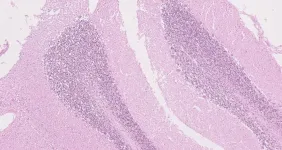(Press-News.org) A new definition of dyslexia is needed to more accurately describe the learning disorder and give those struggling with dyslexia the specific support they require, says new research.
Dyslexia has had several different definitions over the years and this murky and complicated history means it can be a postcode lottery for children who may have dyslexia, or those who have been diagnosed but can’t access the support they need.
The first step to fixing this issue, new research has argued, is to redefine dyslexia and adopt the new definition across the UK.
The research was conducted by the University of Birmingham, the SpLD Assessment Standards Committee (SASC), Kings College London, and the University of Oxford. It is published today (25th Feb) in the Journal of Child Psychology and Psychiatry.
Julia Carroll, Professor of Psychology in Education at the University of Birmingham who led the study, said: “There has not been a new attempt to define dyslexia since the Rose Review in 2009. The review provided a definition and argued for specialist teachers to help identify and support dyslexia. Despite the Rose definition significantly influencing practice, it has gathered criticism over the last 15 years and has not been universally accepted.
“In addition to this, there is no clear universal pathway for the assessment of children with dyslexia in England, Wales and Northern Island, and the process for identifying learning needs and interventions can vary massively from place to place. Adopting a universal definition for dyslexia is the first step to improving support for children experiencing the challenges of dyslexia.”
The researchers brought together 58 international experts in dyslexia, including academics, specialist teachers, educational psychologists, and individuals with dyslexia, to vote on whether they agreed with several key statements about dyslexia. The statements covered six key sections: the definition of dyslexia, intellectual abilities and dyslexia, the etiology of dyslexia, co-occurrence with other disorders, the changing impact of dyslexia over a lifespan, and common misconceptions.
42 statements received a consensus of more than 80% and were accepted by the group. They were then used to create the new definition of dyslexia:
Dyslexia is a set of processing difficulties that affect the acquisition of reading and spelling.
In dyslexia, some or all aspects of literacy attainment are weak in relation to age, standard teaching and instruction, and level of other attainments.
Across languages and age groups, difficulties in reading fluency and spelling are a key marker of dyslexia.
Dyslexic difficulties exist on a continuum and can be experienced to various degrees of severity.
The nature and developmental trajectory of dyslexia depends on multiple genetic and environmental influences.
Dyslexia can affect the acquisition of other skills, such as mathematics, reading comprehension or learning another language.
The most commonly observed cognitive impairment in dyslexia is a difficulty in phonological processing (i.e. in phonological awareness, phonological processing speed or phonological memory). However, phonological difficulties do not fully explain the variability that is observed.
Working memory, processing speed and orthographic skills can contribute to the impact of dyslexia.
Dyslexia frequently co-occurs with one or more other developmental difficulties, including developmental language disorder, dyscalculia, ADHD, and developmental coordination disorder.
Professor Carroll continued: “A definition of a learning disorder such as dyslexia, should allow researchers and practitioners to consistently establish what should, or should not be considered ‘dyslexia’, what the boundaries to diagnosis should include and what elements are important in assessment. Our new definition retains the idea of difficulties with reading and spelling relative to age, ability, or educational expectations. However, it is less focused on English speakers and children. In line with evidence, we highlight that phonological processing has a causal link to dyslexia, but that other factors also play an important role in explaining variability in presentation. We also note the high rates of co-occurrence between dyslexia and other developmental difficulties.”
In a second study from the same group, published in the Dyslexia Journal, the researchers examined ways to improve dyslexia assessments which start with the new definition. The process agreed upon by the expert panel fell into four main steps once a child has presented with difficulties in reading, spelling or writing fluency that affect daily functioning:
Stage 1: Consider, rule out and respond to other factors that might be the primary reason for reading, spelling or writing difficulties.
Stage 2: Gather further information and, where necessary, intervene with additional support fast and early. Be aware of warning signs and likely indicators that suggest the possibility of persistent difficulties.
Stage 3: Observe, record and evaluate response to intervention.
Stage 4: Where response to intervention is stalling or failing, refer for a comprehensive assessment by a specialist teacher assessor or psychologist with appropriate training.
The study argues that, along with the standard definition, there should be a national statutory pathway to dyslexia assessment following this process.
Professor Carroll concluded: “Dyslexia is a complex learning disorder that can look different from person to person. It can have lasting impacts on education and then on working life if not identified and addressed properly. By not having a universal process to identify and support people with dyslexia, we are letting down so many of our children and young people. If the government is serious about improving SEND provision in schools, then updating and standardising the definition and assessment for dyslexia should be a priority.”
ENDS
END
More than half of women ages 30 to 35 are already suffering moderate to severe symptoms associated with menopause, yet most women are waiting decades before seeking treatment, new research from UVA Health and the Flo women’s health app reveals.
The research sheds important light on “perimenopause,” the transition period leading to menopause. Many women in perimenopause assume they’re too young to be suffering symptoms related to menopause, believing that symptoms won’t appear until they reach their 50s. But this ...
Rebels of health care use technology to connect with clinicians, information, and each other
Cambridge, MA – February 25, 2025 – The future of health care is being forged in the crucible of rare disease. A new survey led by Susannah Fox, author of Rebel Health: A Field Guide to the Patient-Led Revolution in Medical Care (The MIT Press), finds that 15% of U.S. households are affected by rare disease or an undiagnosed illness. Their lives are characterized by extreme stress, often matched by their resourcefulness.
“People living with rare diseases push the edges of what is possible by using technology ...
The Beatles said it best: Love is all you need. And according to new research from The Australian National University (ANU), the same is true in the animal kingdom. Well, at least for mosquitofish – a matchstick-sized fish endemic to Central America and now found globally.
According to the ANU scientists, male mosquitofish possess impressive problem-solving skills and can successfully navigate mazes and other tests. Males that perform better have a higher chance of mating.
Lead author Dr Ivan Vinogradov said male mosquitofish ...
Mars is easily identifiable in the night sky by its prominent red hue. Thanks to the fleet of spacecraft that have studied the planet over the last decades, we know that this red colour is due to rusted iron minerals in the dust. That is, iron bound up in Mars’s rocks has at some point reacted with liquid water, or water and oxygen in the air, similar to how rust forms on Earth.
Over billions of years this rusty material – iron oxide – has been broken down into dust and spread all around the planet by winds, a process that continues today.
But iron ...
Statement Highlights:
It is essential for health care professionals to routinely screen pregnant and postpartum women for depression and anxiety, address modifiable risk factors and consider behavioral and pharmacological interventions to improve long-term maternal health outcomes.
Multidisciplinary care teams, including psychologists and other behavioral health professionals, are important to monitor and provide appropriate mental health support during pregnancy and after birth.
The new ...
New research from Emory University indicates that childhood trauma physically alters the hearts of Black women.
The study, which examined the relationship between childhood exposure to trauma and vascular dysfunction among more than 400 Black adults in Atlanta ages 30 to 70, found that women who experienced childhood trauma had a worse vascular function, a preclinical marker of heart disease, while men had none. In addition, the findings show women may be more vulnerable to a larger cumulative stress burden, eliciting varying physiological ...
PROVIDENCE, R.I. [Brown University] — Mars has captivated scientists and the public alike for centuries. One of the biggest reasons is the planet’s reddish hue, earning the third rock from the sun one its most popular nicknames — the “Red Planet.” But what exactly gives the planet its iconic color? Scientists have wondered this for as long as they’ve studied the planet. Today, they may finally have a concrete answer, one that ties into Mar’s watery past.
Results from a new study published in the journal Nature Communications and led by researchers from Brown University and the University of Bern suggest that the water-rich iron mineral ...
Despite what was previously thought, new research has shown that genetic changes alone cannot explain why and where tumours grow in those with genetic condition neurofibromatosis type 1 (NF-1). Understanding more about the factors involved could, in the future, facilitate early cancer detection in NF-1 patients and even point towards new treatments.
Researchers from the Wellcome Sanger Institute, UCL Great Ormond Street Institute of Child Health, Great Ormond Street Hospital, Cambridge University Hospitals NHS Foundation Trust, and their collaborators, focused on NF-1, a genetic condition that causes ...
One particular challenge in the treatment of cancer is therapy resistance. An international research team has now discovered a mechanism that opens up new treatment strategies for tumours in which conventional chemotherapeutic agents have reached their limits. "Cytotoxic agents from nature lead to an increased incorporation of polyunsaturated fatty acids into the membrane of cancer cells. This makes them more susceptible to ferroptosis, a type of cell death, at a very early stage," reports Andreas Koeberle, a pharmacist at the University of Graz and lead author of the study, which has just been published in the scientific journal Nature ...
New York, NY—Feb. 25, 2025— By watching their own motions with a camera, robots can teach themselves about the structure of their own bodies and how they move, a new study from researchers at Columbia Engineering now reveals. Equipped with this knowledge, the robots could not only plan their own actions, but also overcome damage to their bodies.
"Like humans learning to dance by watching their mirror reflection, robots now use raw video to build kinematic self-awareness," says study lead author Yuhang Hu, a doctoral student at the Creative Machines Lab at Columbia University, directed by Hod Lipson, James and Sally Scapa Professor of Innovation and chair of the Department ...






